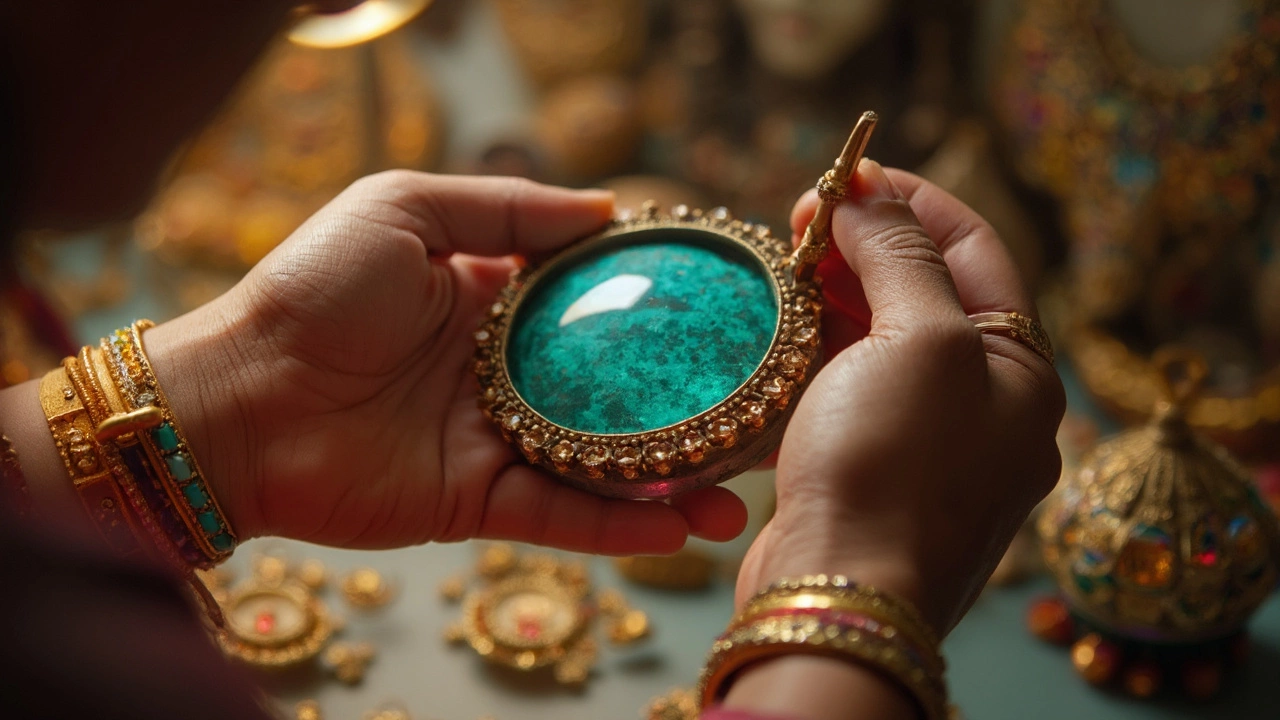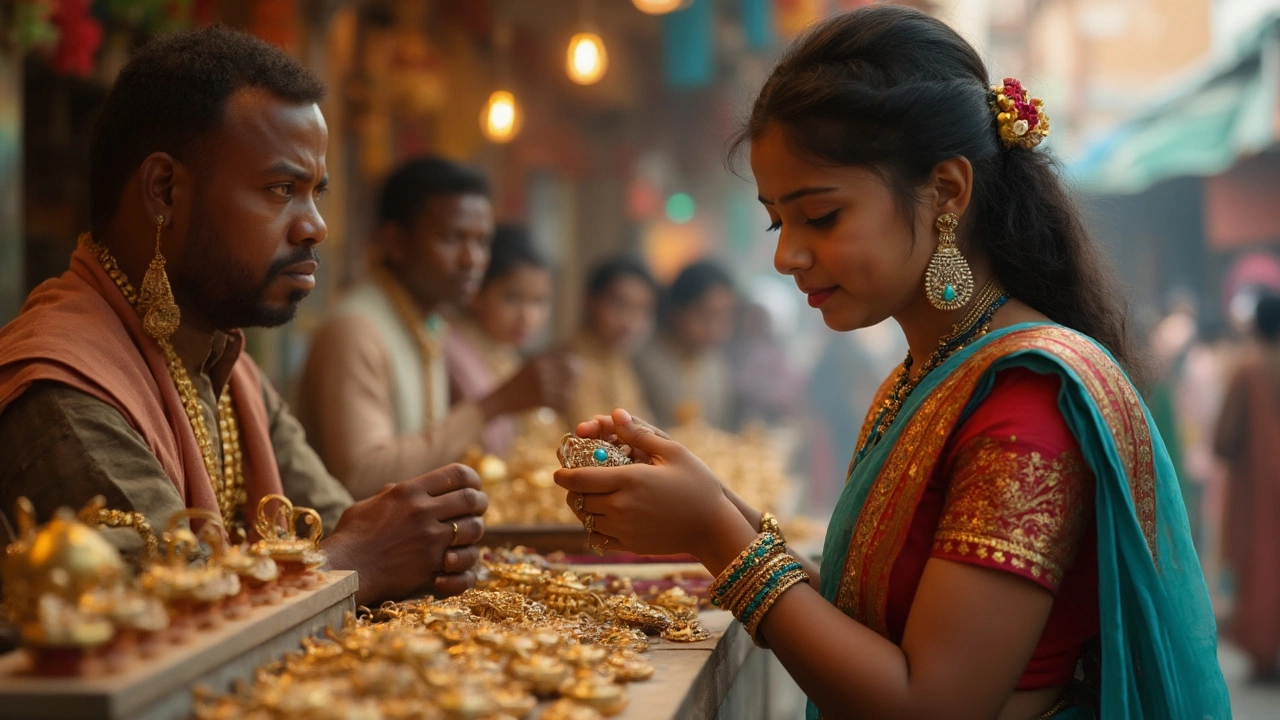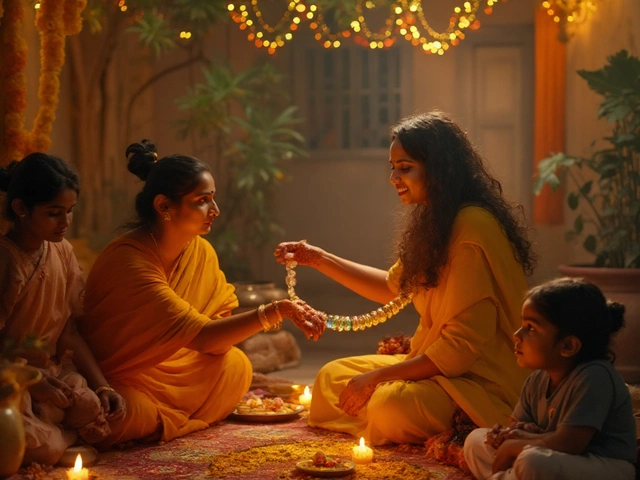
Ever picked up a gorgeous turquoise pendant and felt a twinge of doubt—is this the real thing, or just a convincing copy? You’re not alone. These days, fakes flood the market, especially when it comes to temple jewellery in India. The worst part? Lots of sellers can’t even tell you if what they’re offering is natural or not.
If you’re looking to save yourself cash—and embarrassment—here’s what you need to know right away: real turquoise isn’t perfect. It often has slight color changes, tiny veins called matrix, and a cool, heavy feel. Most fakes? Way too smooth, neon-bright, or suspiciously light, since they’re often dyed howlite or plastic.
Before you buy, remember: a good piece of turquoise adds real history and character to your jewellery. The process of checking it doesn’t need a geology degree. Simple, handy tips will help you sniff out fakes in seconds—and save you from falling for a bad deal.
- Why Real Turquoise Matters in Temple Jewellery
- Spotting Fakes: Easy Home Tests
- Signs of Authentic Turquoise
- Where to Buy with Confidence
Why Real Turquoise Matters in Temple Jewellery
When you’re eyeing a piece of temple jewellery, you want it to feel special and authentic—not something churned out by a factory. Real turquoise has deep roots in Indian jewellery, especially in temple designs from regions like Rajasthan and Gujarat. People used real turquoise in these pieces to draw good luck and positive energy; plenty of families pass these gems down for generations, so you know there’s history attached.
Here’s the thing: real turquoise isn’t just about looks. It’s about long-term value. Natural stones last longer and keep their color, unlike fakes that often fade or peel after a few months. If you’re thinking investment, or something to hand down to your kids, genuine turquoise is just a smarter move. Plus, temple jewellery featuring real turquoise stands out for its weight and presence—it feels substantial, not cheap or flimsy.
Did you know around 60% of turquoise on the global market is either dyed or artificially stabilized to boost its color or strength? This flood of fakes has even hit big jewellery shops in India, not just small market stalls. A real turquoise stone can fetch up to five times more than a fake one of the same size, so the stakes are high if you’re putting down good money.
| Point of Comparison | Real Turquoise | Fake Turquoise |
|---|---|---|
| Origin | Natural, mined in places like Iran, Tibet, Rajasthan (India) | Often dyed howlite or plastic, mostly mass produced |
| Color | Unique blue-green with uneven matrix | Flat, sometimes neon blue |
| Durability | Lasts decades if cared for | Fades, scratches, peels easily |
| Value | High resale and heritage value | Low or none |
If you care about tradition, your wallet, and keeping that classic Indian touch alive, always look for the real turquoise in your temple jewellery.
Spotting Fakes: Easy Home Tests
Not everyone’s got a gem lab at home, but you can still figure out if you’ve got real turquoise or a knock-off with stuff you already have. These quick checks don’t damage the stone, and they’re perfect if you want to catch fakes before you spend any real money.
- Look for Color and Matrix: Natural turquoise never looks plasticky or flat. You want shades that feel almost dusty or have slight variation, plus veins that aren’t perfectly even. Fake turquoise, usually dyed howlite or resin, is wild with bright blue and glass-smooth. If it looks like it came out of a cartoon, trust your gut—it’s likely a fake.
- Use the Pin Test: Gently heat up a sewing pin with a lighter (don’t make it blazing hot, just a few seconds). Press the tip against an unnoticed edge of the stone. If it melts or smells like burning plastic, that’s a dead giveaway it’s resin or plastic. Real stones don’t melt or get soft.
- The Acetone Wipe: Take a cotton bud, dip it in nail polish remover (acetone), and gently rub a tiny area on the side or back of the stone. If blue comes off on the cotton, it’s been dyed. Natural turquoise color won’t rub off—it’s locked in the mineral.
- Feel the Weight: Real turquoise feels cool and solid in your hand. Fakes, especially plastic, feel too light. Stone should have some heft, even if the piece is small.
- Magnifying Glass Wonder: Grab a basic magnifying glass or even your phone’s camera. Organic matrix lines in natural turquoise look random and slightly crackled, not perfectly spaced. If matrix lines are painted on or look too consistent, that’s a clue it’s fake.
Check out this quick comparison to get a clear picture:
| Test | Real Turquoise | Fake Turquoise |
|---|---|---|
| Hot Pin Test | No effect | Melts or smells like plastic |
| Acetone Wipe | No color on cotton | Blue or green dye comes off |
| Weight | Feels heavy, cool | Light, sometimes warm |
| Matrix Lines | Random, imperfect | Painted, too consistent |
Even jewelers in India sometimes get tricked by clever fakes, especially with mass-produced jewellery. A couple of these easy checks before you buy can save you from a lot of headaches (and wasted cash). It beats relying on a shopkeeper’s word any day.

Signs of Authentic Turquoise
Spotting the real stuff isn’t rocket science if you know what to look for. Genuine turquoise has features you can actually feel, see, and sometimes even smell—no joke. Here’s how you tell if you’ve got the real deal or a fake meant to just look good in pictures.
- Color Isn’t Too Perfect: Real turquoise shows subtle color changes—blues and greens, with bits that look cloudier or deeper. Uniform, super-bright blue is a painless way to spot a fake, especially those made from plastic or dyed stones.
- Veins and Matrix: Natural turquoise commonly has spiderweb-like veins or little brown, black, or golden lines. These are bits of the host rock—called “matrix”—that remained when the stone formed. If you see these patterned veins, especially in uneven designs, that’s a solid sign.
- Weight and Feel: Real turquoise feels a little heavy in your hand for its size. Fakes—especially plastic—feel too light or cheap. Seriously, if it feels like a kid’s toy, it probably is.
- Porosity: Run your fingertip across it. Genuine turquoise isn’t glassy-smooth. It feels just a tad gritty, maybe even a bit chalky, because it’s a natural mineral. Hard stones that slide like glass across your finger are likely fakes or overly treated pieces.
- Price Tag: If you find turquoise at rock-bottom prices, especially in places selling piles of identical pieces, be wary. Real turquoise is not dirt-cheap, especially if it’s used in temple jewellery that’s supposed to be handmade or antique.
Here’s a quick comparison to make it easier:
| Feature | Real Turquoise | Fake Turquoise |
|---|---|---|
| Color | Varies, blue-green with natural inconsistencies | Uniform, overly bright or pure blue |
| Veins/Matrix | Distinct, uneven, web-like patterns | Painted or missing entirely |
| Weight | Feels solid, heavier than plastic | Lightweight, especially plastic fakes |
| Surface Feel | Slightly rough, porous | Very smooth, glossy or slippery |
| Price | Priced higher, rarely cheap | Usually cheap, especially with bulk deals |
One final thing: when you see the term real turquoise in product descriptions, make sure they’re backing that up with details like origin (think Nepal, Persia, or Arizona mines) or lab reports. Sellers who waffle or get defensive when you ask might not be offering genuine stones.
Where to Buy with Confidence
If you want real turquoise, especially for temple jewellery in India, you need to pick your seller carefully. Lots of shops—both online and offline—mix in lookalikes or reconstituted stones and call them natural. Good news: there are ways to avoid the scams and get what you pay for.
First up, stick with established jewellers or stores known for selling ethnic and temple jewellery. In cities like Jaipur and Hyderabad, some shops specialize in real gemstones and have been around for generations. They usually give certificates of authenticity and don’t mind if you want to do a few quick tests.
If you’re shopping online, look for these things before hitting the buy button:
- Real turquoise is always mentioned in the product details. If the listing says “turquoise,” but it looks suspiciously cheap or just says “turquoise color,” move along.
- The seller shows close-up photos. You should be able to see the matrix (those natural spiderweb veins) and any imperfections.
- Reputation matters. Big sites like Tanishq, CaratLane, or even Amazon India’s certified sellers have strict guidelines, but if you’re on a new website or Instagram shop, check for real reviews with actual pictures.
- The shop offers a fair return or exchange policy if you’re not convinced.
In local Indian markets, haggling is normal, but if the price drops too fast or the seller gets jumpy when you ask questions, that’s a red flag. Real stones cost more—there isn’t a way around it. As of 2024, high-quality natural turquoise in India typically sells for ₹600 to ₹2000 per gram, depending on color and origin.
| Source | What to Check | Risk Level |
|---|---|---|
| Local Markets | Ask for origin, check color, negotiate carefully | Medium-High |
| Certified Jewellers | Certificate, established brand | Low |
| Handicraft Stores | Inspect for plastic or dyed stones | Medium |
| Online Marketplaces | Reviews, seller rating, close-up photos | Medium |
When in doubt, bring a small magnifying glass to the shop. Natural turquoise usually shows uneven patterns under magnification—machine-made stuff looks too smooth. If you want to splash out on expensive pieces, consider asking for lab testing or a gem certificate from a reputed source like GIA India or IGI. Real dealers won’t bat an eye at these requests.




